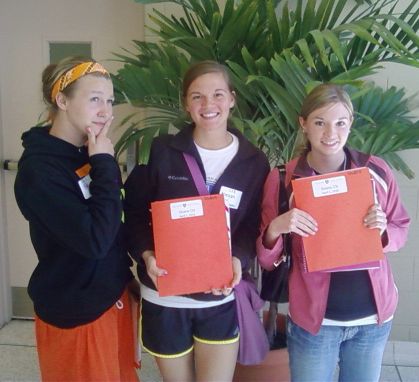Three WHS Students Participate in Doane's 2010 CSI Murder Mystery Competition
Student Workshops Teach Numerous Crime Scene Analysis Techniques
Emily Brodahl, Morgan Hancock, and Kristin Daniel, along with Mr. Shannon, traveled to Doane College on April 1 to participate in the 2010 Doane CSI Murder Mystery competition.
Teams from across Nebraska converged on Doane’s campus to take part in a series of workshops that would help provide clues to who killed Dr. Dee Anay and Dr. Paige Turner.
Please click HERE to view the storyline for this year's competition.
Each of the students attended three of the workshops listed below and learned how crime scene analysts use each of the techniques to gather information.
Autopsy Analysis
Some of the best clues about a murder come from the corpse. Although it can’t talk, it can reveal a lot of information about the events that occurred before, during, and after a crime. In this workshop students will observe first-hand what is involved in an autopsy. Students will view a real human cadaver.
Blood Detection
How can trace amounts of blood be detected, despite a criminal's best attempts to clean it? In this workshop, students will learn about methods used to find blood at a crime scene so that it can be used to analyze the scenario surrounding the crime.
Blood Spatters
In this session, participants will investigate blood spatters and spatter patterns. They will learn how blood spatters are used to determine the source of the blood, the source’s location at the crime scene, and the method (such as gun shot or stabbing) that produced the blood spatter pattern.
DNA Fingerprinting
DNA evidence at crime scenes was made famous during the O.J. Simpson trial. What is a DNA fingerprint, and what does it tell us? Students will learn how to produce a DNA fingerprint using gel electrophoresis and will analyze DNA patterns using a gel-doc system.
Drug Detection by IR
Forensic analysts need to be able to tell if a sample found at a crime scene is an abused narcotic or just some spilled baking soda. Students will learn about laboratory methods used to identify unknown samples.
Fiber Analysis
Hair discovered at the scene of a crime can give important information. Does the hair belong to a human or an animal? Can you identify which animal or person a hair belongs to based on microscopic examination? Students will examine different types of hairs using a scanning electron microscope and may uncover some valuable information about this year's crime.
Fingerprinting
In today’s high-tech crime lab, there is often a lot of focus on the DNA fingerprint, but don’t underestimate the importance of the good old-fashioned finger fingerprint! Learn how to collect fingerprint evidence and distinguish among the characteristics that make us unique.
Forensic Entomology
How can we use entomology - the study of insects - to help us solve a crime? Students will investigate how insects and other natural clues can provide valuable information about when a crime occurred.
Trace Chemical Analysis by GC and Mass Spec
Many trace elements can be detected on victims and suspects, linking them to specific locations or living conditions. Copper concentrations in hair are unique for every individual, but proper lab techniques are required to use this information to make a match.
Students then combined their newfound clues, along with the original script to come up with their final analysis of what occurred. Everyone thoroughly enjoyed the experience and look forward to the opportunity to participate in the challenge again next year.


 Launch the media gallery 1 player
Launch the media gallery 1 player